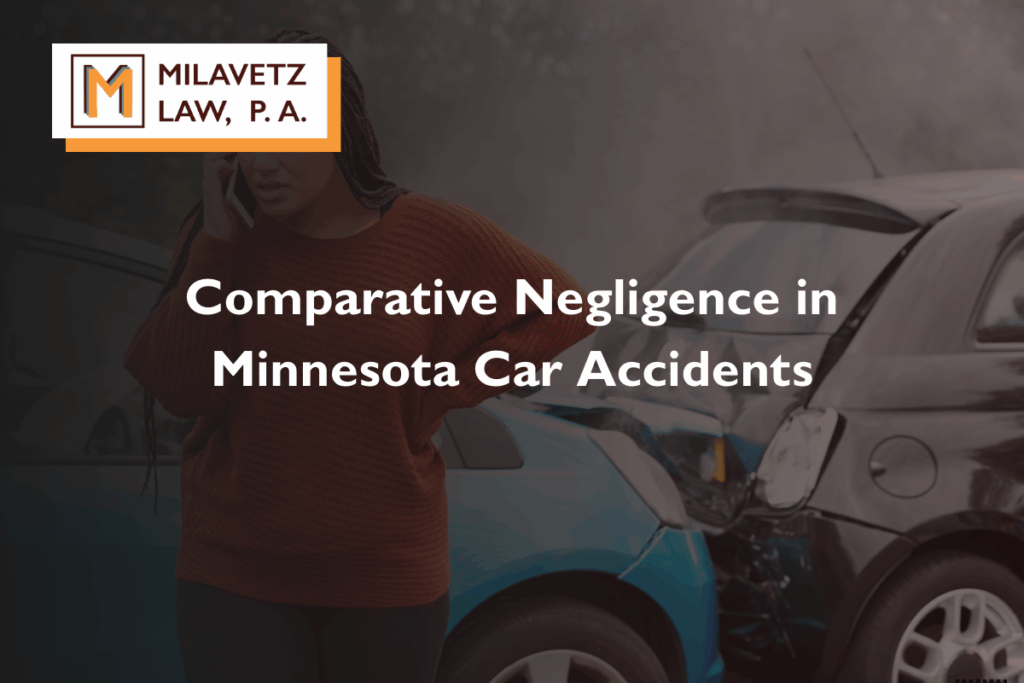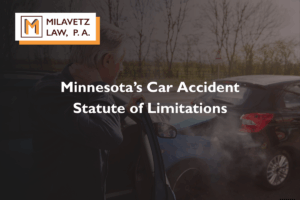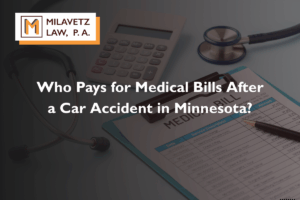
Sometimes, a person injured in a car accident may be partly at fault for the accident. In these cases, Minnesota laws on modified comparative negligence will reduce the compensation the plaintiff recovers based on their degree of responsibility in the accident. The car accident lawyers at Milavetz Law, P.A., are ready to help car accident victims in Minnesota recover compensation for any injury they suffered because of another person’s fault.
Proving a defendant’s action caused the accident is usually complex and challenging, especially in car accident cases. But the law is straightforward: You may recover compensation if you prove the defendant’s negligence caused the accident and your injuries. However, if your negligence contributed to the accident, things can get even more complex.
Minnesota has a modified comparative negligence rule that determines whether you can recover compensation for your injuries and what percentage of the damages you can recover.
Even if you think you were partly at fault in an accident that caused you harm, you may still recover damages. Our Minnesota car accident attorneys at Milavetz Law, P.A., have extensive experience in these cases. We can help you prove your case and earn you your rightful compensation.
What Is Comparative Negligence?
Comparative negligence is a legal rule used to apportion fault and calculate damages in accident cases. It reduces the damages a plaintiff can recover in a personal injury claim based on their degree of fault.
Traditionally, the common law operated on the principle of contributory negligence, which bars plaintiffs from recovering any compensation if they were even slightly responsible for their injuries. However, almost all U.S. states have abandoned this approach and embraced a comparative negligence rule. Only Alabama, Maryland, North Carolina, Virginia, and Washington, D.C., still adhere to the strict contributory negligence rule.
The comparative negligence principle comes into play when the plaintiff’s negligence contributed to the incident. For example, Andrew drives over the speed limit at night and rear-ends Becky’s car. Becky sues Andrew, claiming damages. However, Andrew claims that Becky was partly to blame because Becky’s taillight wasn’t working.
If the court agrees that Becky shares part of the blame, this alters the case, meaning Becky may not receive full compensation as she hoped. Her recovery would likely be reduced in proportion to her share of the blame for having a faulty taillight.
If you’ve been in a car accident in Minneapolis, our Minneapolis car accident lawyers at Milavetz Law, P.A., can help you determine fault, strengthen your case, and prove your claim. Call or chat with us at 763-560-0000 and schedule a free consultation.
Minnesota's Modified Comparative Negligence Law
If the court decides the plaintiff was partly at fault for the injury, it will assign percentages of fault to the plaintiff and the defendant. Minnesota’s modified comparative negligence rule, stated in Minnesota Statute Section 604.01, allows a person to recover damages for an injury if their degree of fault is not greater than the defendant’s.
This modified comparative negligence law is commonly known as the 51 Percent Bar Rule. If the court assigns the plaintiff a percentage of fault of 51 percent or more, they cannot recover damages. If the plaintiff is 50 percent or less responsible for the accident, they can recover damages in proportion to their share of the fault. This means thee court will also reduce the damages the plaintiff can recover by their percentage of the fault.
For instance, in the rear-end accident involving Andrew and Becky, if Becky claims $100,000 in damages and the court determines she is 40 percent at fault, the court will reduce her compensation by 40 percent. Becky will recover $60,000 instead of $100,000.
It’s important to note that Minnesota’s modified comparative negligence rules differ from some other states’ comparative negligence principles. Some comparative negligence states allow the plaintiff to recover even if their percentage of fault is greater than that of the defendant. In a pure comparative law state, if your percentage of fault is 80 percent, you could still recover compensation for the defendant’s 20 percent fault.
In addition, some modified comparative negligence states do not allow the plaintiff to recover if they are 50 percent responsible for the accident. However, you can recover in Minnesota if you split fault with the defendant 50/50.
If you have any questions on how Minnesota’s modified comparative negligence works and how it could impact your car accident case, our Minnesota car accident lawyers at Milavetz Law, P.A., can help. Contact us online or at 763-560-0000.
How Do You Prove Negligence in a Car Accident Lawsuit?
To succeed in a car accident lawsuit, you must prove the defendant was negligent. Negligence is a failure to exercise the level of care a reasonable person would exercise under similar circumstances.
There are five elements you need to provide evidence for to prove negligence.
Duty of Care
Duty of care refers to the relationship between the plaintiff and the defendant. It places responsibility on the defendant to behave in a certain way. Because a driver’s actions can endanger other road users, it’s a settled fact that drivers owe other drivers, passengers, and pedestrians a duty of care. This usually is easy to prove in a car accident lawsuit. However, you generally need more than just duty of care evidence in a strong case.
Breach of Duty
It’s insufficient to prove the defendant owed you a duty of care. You must also show they breached that duty by their action or inaction. Establishing a breach of duty requires you to show the defendant acted unreasonably. In a car accident lawsuit, it would be enough to prove that the defendant was speeding, driving under the influence, texting while driving, running a red light, or tailgating, among other examples.
Cause
You must prove the defendant’s actions were the actual cause of the accident and your injury. This is often referred to as the “but for” test, which asks: “But for the actions of the defendant, would the injury have happened?” In other words, you are saying your injury would not have occurred if the defendant had not acted the way they did.
Proximate Cause
Proximate cause considers whether the defendant could have anticipated your injuries would likely result from their action. The court won’t hold a defendant liable for an injury if it was not reasonably foreseeable.
Damages
Finally, you must demonstrate how you were harmed. It can be a physical injury to your body or your property. This is vital essential: Even if the court finds the defendant’s actions breached their duty of care, you may not be able to recover any damages if you didn’t suffer any injury.
We Can Answer Your Questions About Minnesota’s Negligence Laws
If you’ve been injured in a car accident, Minnesota’s modified comparative negligence rule allows you to recover compensation for your injuries as long as your percentage of fault is not greater than the defendant’s. However, the court may reduce the compensation by the degree of your responsibility.
If you have any questions about comparative negligence in Minnesota and how it can impact your case, a car accident attorney can provide answers. Our experienced accident lawyers at Milavetz Law, P.A., are ready to answer any questions you have. We’ll explain how Minnesota’s modified comparative negligence rule will apply in your case and how to receive the maximum compensation.
Contact us today and schedule a free consultation. Discover how we can help you prove your case and fight for your right to receive compensation.
















